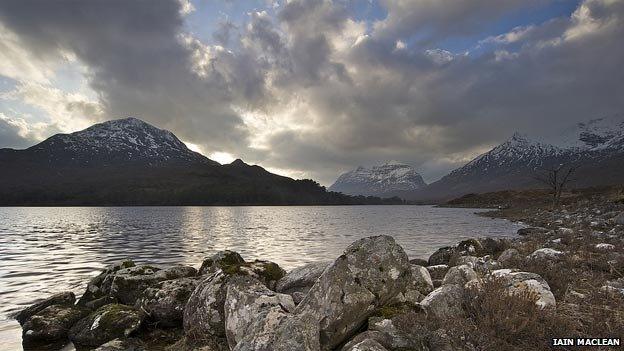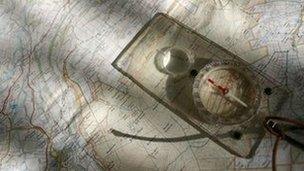Should walkers worry about magnetic north shifting?
- Published

Movement below the Earth's surface has shifted magnetic north
Magnetic north has made an unusual and historic shift but how does that affect walkers in Scotland's hills?
For those who navigate Great Britain's landscape by map and compass there are three norths.
Grid north is the direction of a grid line which is parallel to the central meridian on the National Grid, external, the reference system on Ordnance Survey maps.
True north is the direction of a meridian of longitude, an imaginary circle of the Earth, which converges on the North Pole.
Magnetic north is the direction magnetic compasses point to.
It is always shifting, very slowly, influenced by changes in the Earth's magnetic field which is itself affected by changes to the spinning of the planet's core.
For the first time in more than 220 years of map making, Ordnance Survey has noted that it lies east, and not west, of grid north for parts of southern Britain., external
But how does that affect map reading in Scotland's hills?
Heather Morning, mountain safety officer at the Mountaineering Council of Scotland, tackles the question:
"If you head out into the Scottish mountains, you can't fail to have had a conversation with your hill walking companions along the lines of: 'Does anyone know what the current magnetic variation is?
'How much do we adjust our compass bearings by?'
There is certainly an extensive collection of mountain myths around the subject - so perhaps it is time to put the records straight.
Hillwalkers may well have broken into a cold sweat when reading recent attention-grabbing headlines about magnetic north moving east.
Not having this up-to-date knowledge may conjure up visions of walking innocently over a cornice and tumbling to your doom in white-out conditions.
But it is not quite as dramatic as that.

Magnetic compasses indicate the direction of magnetic north
There is all sorts of science involved but, for the less scientific among us, it is simple.
The maps we use on the hill are aligned to what is known as grid north.
The compasses we use on the hill work with the Earth's magnetic field and line up with magnetic north.
There is a difference between the two - the result of trying to reproduce a spherical world with a flat map - and that varies with time and depending on where you are in the world.
So, for example, the difference between grid and magnetic north here in Scotland is very different to that in South America.
For the geeks among us, there is a website, external where you can punch in your location details and receive the current magnetic variation for your desired location.
If the results show to be west of grid north this means, in practical terms, the user needs to "add on" to the bearing that has been taken from the map.
So, for example, if a bearing from the map in the Cairngorm area was 48 degrees the user should add on a further two degrees and walk on a 50 degree bearing.
If the result of your search was a bearing east of grid north - as is now the case in deepest Cornwall - then this figure should be deducted.
So back to the question: does it matter?
Each tiny black line on the compass housing represents two degrees, so it is impossible to differentiate the tiny adjustments required for 100% accuracy.
And when you then factor in the human element of walking on the bearing, this degree of accuracy is, to be honest, probably irrelevant.
That said, in full-on winter white-out conditions near corniced edges I am adding on my two degrees.
It is also worth noting that over the next few years here in Scotland, this variation will gradually decrease to zero.
And that - for a time - will be one less thing for mountaineers to worry about."